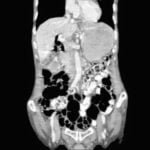
Management of ascites in cirrhosis
Management of ascites in cirrhosis
Grading of ascites:
Grade I Detected by USG only , Grade II moderate ascites , Grade III gross ascites
Characteristics of ascites in CLD: wide gradient SAAG >1.1
Recommendations
1. A diagnostic paracentesis should be performed in all patients with new-onset grade 2 or 3 ascites, and in all patients hospitalized for worsening of ascites or any a complication of cirrhosis (Level A1).
2. Neutrophil count and culture of ascitic fluid (by inoculation into blood culture bottles at the bedside) should be performed to exclude bacterial peritonitis (Level A1).
3. It is important to measure ascitic total protein concentration since patients with an ascitic protein concentration of less than 15 g/L have an increased risk of developing spontaneous bacterial peritonitis (Level A1) and may benefit from antibiotic prophylaxis (Level A1).
4. Measurement of the serum–ascites albumin gradient may be useful when the diagnosis of cirrhosis is not clinically evident or in patients with cirrhosis in whom a cause of ascites different than cirrhosis is suspected (Level A2).
5. Moderate restriction of salt intake is an important component of the management of ascites (intake of sodium of 80–120 mmol/day, which corresponds to 4.6– 6.9 g of salt/day) (Level B1). This is generally equivalent to a no added salt diet with avoidance of pre-prepared meals.
6. There is insufficient evidence to recommend bed rest as part of the treatment of ascites. There are no data to support the use of fluid restriction in patients with ascites with normal serum sodium concentration (Level B1).
7. Patients with the first episode of grade 2 (moderate) ascites should receive an aldosterone antagonist such as spironolactone alone, starting at 100 mg/day and increasing stepwise every 7 days (in 100 mg steps) to a maximum of 400 mg/day if there is no response (Level A1).
8. In patients who do not respond to aldosterone antagonists, as defined by a reduction of body weight of less than 2 kg/ week, or in patients who develop hyperkalemia, furosemide should be added at an increasing stepwise dose from 40 mg/day to a maximum of 160 mg/day (in 40 mg steps) (Level A1).
9. Patients should undergo frequent clinical and biochemical monitoring particularly during the first month of treatment (Level A1).
10. Patients with recurrent ascites should be treated with a combination of an aldosterone antagonist plus furosemide, the dose of which should be increased sequentially according to response, as explained above (Level A1). The maximum recommended weight loss during diuretic therapy should be 0.5 kg/day in patients without edema and 1 kg/day in patients with edema (Level A1).
11. The goal of long-term treatment is to maintain patients free of ascites with a minimum dose of diuretics. Thus, once the ascites has largely resolved, the dose of diuretics should be reduced and discontinued later, whenever possible (Level B1).
12. Caution should be used when starting treatment with diuretics in patients with renal impairment, hyponatremia, or disturbances in serum potassium concentration and patients should be submitted to frequent clinical and biochemical monitoring. There is no good evidence as to what is the level of severity of renal impairment and hyponatremia in which diuretics should not be started. Serum potassium levels should be corrected before commencing diuretic therapy. Diuretics are generally contraindicated in patients with overt hepatic encephalopathy (Level B1).
13. All diuretics should be discontinued if there is severe hyponatremia (serum sodium concentration <120 mmol/L), progressive renal failure, worsening hepatic encephalopathy, or incapacitating muscle cramps (Level B1).
14. Furosemide should be stopped if there is severe hypokalemia (<3 mmol/L). Aldosterone antagonists should be stopped if patients develop severe hyperkalemia (serum potassium >6 mmol/L) (Level B1).
15. Large-volume paracentesis (LVP) is the first-line therapy in patients with large ascites (grade 3 ascites) (Level A1). LVP should be completed in a single session (Level A1). LVP should be performed together with the administration of albumin (8 g/L of ascitic fluid removed) to prevent circulatory dysfunction after LVP (Level A1).
16. Non-steroidal anti-inflammatory drugs (NSAIDs) are contraindicated in patients with ascites because of the high risk of developing further sodium retention, hyponatremia, and renal failure (Level A1).
17.Drugs that decrease arterial pressure or renal blood flow such as ACE-inhibitors, angiotensin II antagonists, or a1- adrenergic receptor blockers should generally not be used in patients with ascites because of increased risk of renal impairment (Level A1).
18.The use of aminoglycosides is associated with an increased risk of renal failure. Thus, their use should be reserved for patients with bacterial infections that cannot be treated with other antibiotics (Level A1). In patients with ascites without renal failure, the use of contrast media does not appear to be associated with an increased risk of renal impairment (Level B1). In patients with renal failure, there are insufficient data. Nevertheless, contrast media should be used with caution and the use of general preventive measures of renal impairment is recommended (Level C1).
19. Refractory ascites:
Repeated large-volume paracentesis plus albumin (8 g/L of ascites removed) is the first line of treatment for refractory ascites (Level A1).
Diuretics should be discontinued in patients with refractory ascites who do not excrete >30 mmol/day of sodium under diuretic treatment. TIPS is effective in the management of refractory ascites but is associated with a high risk of hepatic encephalopathy and studies have not been shown to convincingly improve survival compared to repeated large-volume paracentesis (Level A1).
TIPS should be considered in patients with a very frequent requirement of large-volume paracentesis, or in those in whom paracentesis is ineffective (e.g. due to the presence of loculated ascites) (Level B1).
The resolution of ascites after TIPS is slow and most patients require continued administration of diuretics and salt restriction (Level B1).
TIPS cannot be recommended in patients with severe liver failure (serum bilirubin >5 mg/dl, INR >2 or Child-Pugh score >11, current hepatic encephalopathy Grade 2 or chronic hepatic encephalopathy), concomitant active infection, progressive renal failure, or severe cardiopulmonary diseases (Level B1).
In selected patients, TIPS may be helpful for recurrent symptomatic hepatic hydrothorax (Level B2).
View in browser :The Health Guide
Join the mailing list!
Get the latest articles delivered right to your inbox!




